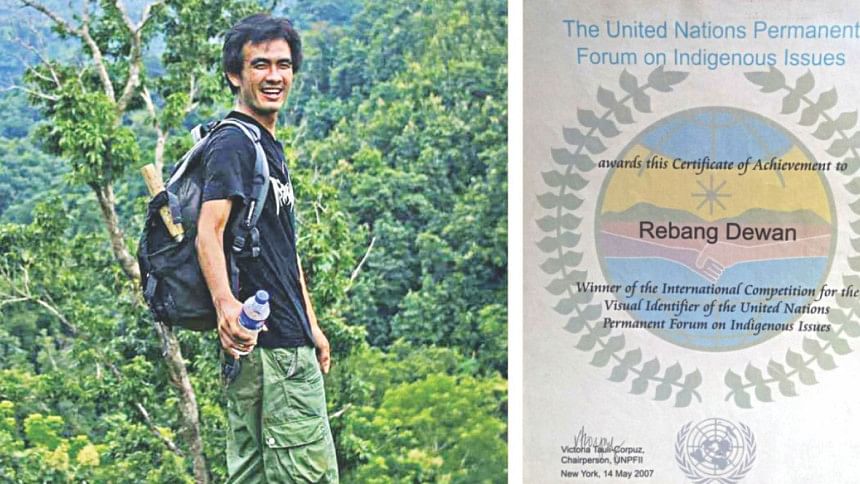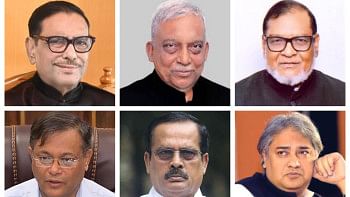The indigenous boy who drew a logo for UN

In the flowing hills of Rangamati sits the small village of Bhedbhedi. This is where Rebang Dewan grew up frolicking around with his friends. The village encapsulates almost all the features of natural beauty the hills have to offer—clouds passing through the huts, occasional flashes of lightning seen from the distance, pattering rain on the roofs, glimpses of a rainbow, and rain-drenched verdant greenery.
In 2007, at the age of 12, the Chakma boy accomplished what many would only dream of. He became one of hundreds of indigenous children from 140 countries that took part in a competition to design the logo for the United Nations Permanent Forum on Indigenous Issues (UNPFII). Going beyond the national boundary, he beat every other contestant from around the world and won the first prize.
The artwork, titled “Handshake” by Rebang is now the visual identifier of this UN forum. Since after the contest, it has been used in the official works of UNPFII as logo. It is also seen on materials to promote International Day of the World's Indigenous People. On this day every year, his artwork often accompanies the UN logo.
The logo features two stems of green leaves cradling a globe. Within the globe is a picture of a handshake in the middle and a hilly landscape in the background with a rising sun.
Rebang, now a second-year anthropology student of Dhaka University, said the handshake is a symbol of communal harmony between Bangalee and indigenous people, while the rising sun symbolises heralding of friendship between the state and indigenous communities.
But what works behind a child's mind is far from what the state thinks.
After the boy's success in the global competition which brought the country honour, fear gripped his parents. They sent their young son away from where he wanted to grow up in nature just like every other Bangalee boy.
“The artwork came out of a child's mind. I drew it with the hope of getting a world where people from every community would live in peace, but in reality, two years after the global contest, I was sent to Comilla Ispahani School and College from my village home Bhedbhedi in Rangamati for the fear of repression on indigenous communities,” said Rebang, now 24.
After he entered university, Rebang was elected general secretary of Bangladesh Indigenous Students' Organisation. He hardly visits the place of his birth in fear that he might be just another victim of repression on indigenous people.
The youth said, “My parents fear that one day I may not return home like Kalpana Chakma (an indigenous rights leader) if I stay in the hills.”
Kalpana, then organising secretary of the Hill Women's Federation, was abducted from her Rangamati home on June 11, 1996, never to return again.
The story of Rebang resonates with the plight of indigenous communities in Bangladesh.
On September 13, 2007, the UN Declaration on the Rights of Indigenous Peoples (UNDRIP) was adopted at the UN General Assembly. UNDRIP is a landmark accomplishment for the member-states recognising the rights of the world's indigenous population. The declaration encourages harmonious and cooperative relations between the states and indigenous peoples.
Eleven years into the adoption of UNDRIP, Canada, which voted against the declaration, recently reversed its position, and now supports the declaration while Bangladesh is one of the 11 countries that abstained from voting and has not changed its position yet. However, different governments have promised several times to work together with the indigenous communities for the implementation of UNDRIP.
In Bangladesh, indigenous communities are facing torture and discrimination over the years due to the state's refusal to identify them as “indigenous” in the constitution, lack of recognition of their traditional land rights, denial of access to justice, and lack of proper representation in decision-making levels, said Rebang.
The recent arson attacks in Longadu, alleged extrajudicial killing of Romel Chakma, the case of Santal farmers of Sahebganj-Bagda Farm in Gaibandha, rape and harassment of two Marma sisters, and murder of fourth grader Kritika Tripura after rape are some of the vivid examples of what these minority communities live through.
There are around three million indigenous people in the plain lands and the hills in the country, according to Bangladesh Adivasi Forum.
These ethnic communities saw a ray of hope after the Chittagong Hill Tracts Peace Accord was signed in 1997, but major provisions of the agreement, involving land disputes resolution, withdrawal of temporary military camps, and devolution of power to the local bodies, are yet to be fulfilled, said the student leader.
Rebang once dreamt of becoming a painter. Now he wants to fight for indigenous people's rights to education, health, employment, and language for the rest of his life. He still believes what he believed as a child—the sun of friendship will rise one day.

 For all latest news, follow The Daily Star's Google News channel.
For all latest news, follow The Daily Star's Google News channel. 



Comments